A Novel Design of a Sliding Mode Controller Based on Modified ERL for Enhanced Quadcopter Trajectory Tracking
Abstract
1. Introduction
- 1.
- A new optimal adaptive sliding mode controller based on modification of ERL for an underactuated quadcopter system is developed that is employed under various simulation experiments like a trajectory tracking mission, automated take-off and landing, and altitude and attitude control in nominal mode, input variation mode, parametric uncertainty mode, and unknown disturbances mode.
- 2.
- Elimination of the chattering effect caused by the switching sliding surface is conducted by employing a smooth continuous signum function as a substitute for the signum function. Then, the chattering effect is eliminated with the proposed SMC compared to that observed with classical SMC.
- 3.
- All factors influencing the quadcopter’s dynamics, including gyroscopic effects, drag forces along the (x, y, z) axes, frictions from aerodynamic torque, and high-level non-holonomic limitations, were considered when designing the controller.
- 4.
- Stability of the quadrotor’s trajectory tracking and attitude control system is demonstrated using Lyapunov’s theory.
- 5.
2. Nonlinear Quadcopter Dynamic Modeling
- 1.
- The quadcopter has a symmetrical architecture with a rigid body and rigid propellers.
- 2.
- The body-fixed frame origin is precisely the quadcopter’s center of mass.
- 3.
- Drag and thrust forces are proportionate to the rotor speed squared.
3. Problem Statement
4. Control Design
4.1. Classical SMC Design Based on ERL
4.2. SMC Design Based on ERL Using Saturation Function
4.3. Adaptive SMC Design Based on Modified ERL
5. Optimal SMC and Performance Indices
5.1. Basics of Particle Swarm Optimization
5.2. Optimal SMC Based on PSO
5.3. Performance Indices
6. Simulation and Results
6.1. Hovering Flight Under Attitude Stabilization
6.2. Trajectory Tracking Flight in the Presence and Absence of Disturbances
6.3. Trajectory Tracking Flight Under Input Variation in the Presence of Disturbances
6.4. Trajectory Tracking Flight Under Random Noise and Parameter Variation in the Presence of Disturbances
7. Conclusions
Author Contributions
Funding
Data Availability Statement
Conflicts of Interest
References
- Bouabdallah, S.; Noth, A.; Siegwart, R. PID vs. LQ control techniques applied to an indoor micro quadrotor. In Proceedings of the 2004 IEEE/RSJ International Conference on Intelligent Robots and Systems (IROS) (IEEE Cat. No. 04CH37566), Sendai, Japan, 28 September–2 October 2004; IEEE: Piscataway, NJ, USA, 2004; Volume 3, pp. 2451–2456. [Google Scholar]
- Lopez-Sanchez, I.; Moreno-Valenzuela, J. PID control of quadrotor UAVs: A survey. Ann. Rev. Control 2023, 56, 100900. [Google Scholar] [CrossRef]
- Ayad, R.; Nouibat, W.; Zareb, M.; Bestaoui Sebanne, Y. Full control of quadrotor aerial robot using fractional-order FOPID. Iran. J. Sci. Technol. Trans. Electr. Eng. 2019, 43, 349–360. [Google Scholar] [CrossRef]
- Kayacan, E.; Maslim, R. Type-2 fuzzy logic trajectory tracking control of quadrotor VTOL aircraft with elliptic membership functions. IEEE/ASME Trans. Mechatron. 2016, 22, 339–348. [Google Scholar] [CrossRef]
- Tang, Y.R.; Xiao, X.; Li, Y. Nonlinear dynamic modeling and hybrid control design with dynamic compensator for a small-scale UAV quadrotor. Measurement 2017, 109, 51–64. [Google Scholar] [CrossRef]
- Saif, A.W.A.; Gaufan, K.B.; El-Ferik, S.; Al-Dhaifallah, M. Fractional order sliding mode control of quadrotor based on fractional order model. IEEE Access 2023, 11, 79823–79837. [Google Scholar] [CrossRef]
- Yongjun, D.; Jianhong, W.; Jinlong, Z.; Xi, L. Design of quadcopter attitude controller based on data-driven model-free adaptive sliding mode control. Int. J. Dyn. Control 2024, 12, 1404–1414. [Google Scholar] [CrossRef]
- Jinlong, Z.; Jianhong, W.; Ruchun, W.; Xi, L.; Yongjun, D.; Azar, A.T.; Ahmed, S.; Hameed, I.A.; Zalzala, A.M.; Ibraheem, I.K. Control Design of the Quadrotor Aircraft based on the Integral Adaptive Improved Integral Backstepping Sliding Mode Scheme. Eng. Technol. Appl. Sci. Res. 2024, 14, 17106–17117. [Google Scholar] [CrossRef]
- Razmi, H.; Afshinfar, S. Neural network-based adaptive sliding mode control design for position and attitude control of a quadrotor UAV. Aerosp. Sci. Technol. 2019, 91, 12–27. [Google Scholar] [CrossRef]
- Raffo, G.V.; Ortega, M.G.; Rubio, F.R. An integral predictive/nonlinear H∞ control structure for a quadrotor helicopter. Automatica 2010, 46, 29–39. [Google Scholar] [CrossRef]
- Besnard, L.; Shtessel, Y.B.; Landrum, B. Quadrotor vehicle control via sliding mode controller driven by sliding mode disturbance observer. J. Frankl. Inst. 2012, 349, 658–684. [Google Scholar] [CrossRef]
- Guo, L.; Xiong, W.; Zhao, H.; Song, Y.; Gan, D. A nearly optimal adaptive saturation function tuning method for quasi-sliding mode control based on integral reinforcement learning. Neurocomputing 2025, 623, 129363. [Google Scholar] [CrossRef]
- Ko, Y.R.; Hwang, Y.; Chae, M.; Kim, T.H. Direct identification of generalized Prandtl–Ishlinskii model inversion for asymmetric hysteresis compensation. ISA Trans. 2017, 70, 209–218. [Google Scholar] [CrossRef]
- Xiong, J.J.; Zheng, E.H. Position and attitude tracking control for a quadrotor UAV. ISA Trans. 2014, 53, 725–731. [Google Scholar] [CrossRef]
- Singla, M.; Shieh, L.S.; Song, G.; Xie, L.; Zhang, Y. A new optimal sliding mode controller design using scalar sign function. ISA Trans. 2014, 53, 267–279. [Google Scholar] [CrossRef]
- Abdelmaksoud, S.I.; Mailah, M.; Abdallah, A.M. Control strategies and novel techniques for autonomous rotorcraft unmanned aerial vehicles: A review. IEEE Access 2020, 8, 195142–195169. [Google Scholar] [CrossRef]
- Khalid, A.; Mushtaq, Z.; Arif, S.; Zeb, K.; Khan, M.A.; Bakshi, S. Control schemes for quadrotor UAV: Taxonomy and survey. ACM Comput. Surv. 2023, 56, 1–32. [Google Scholar] [CrossRef]
- El Gmili, N.; El Hamidi, K.; Mjahed, M.; El Kari, A.; Ayad, H. Intelligent sliding mode control for quadrotor trajectory tracking under external disturbances. Electrica 2024, 24, 1–14. [Google Scholar] [CrossRef]
- Bouadi, H.; Bouchoucha, M.; Tadjine, M. Sliding mode control based on backstepping approach for an UAV type-quadrotor. World Acad. Sci. Eng. Technol. 2007, 26, 22–27. [Google Scholar]
- Xu, G.; Xia, Y.; Zhai, D.H.; Ma, D. Adaptive prescribed performance terminal sliding mode attitude control for quadrotor under input saturation. IET Control Theory Appl. 2020, 14, 2473–2480. [Google Scholar] [CrossRef]
- Liu, J. Sliding Mode Control Using MATLAB; Academic Press: Cambridge, MA, USA, 2017. [Google Scholar]
- Fang, J.; Zhang, L.; Long, Z.; Wang, M.Y. Fuzzy adaptive sliding mode control for the precision position of piezo-actuated nano positioning stage. Int. J. Precis. Eng. Manuf. 2018, 19, 1447–1456. [Google Scholar] [CrossRef]
- Sun, X.; Zhu, Y.; Cai, Y.; Yao, M.; Sun, Y.; Lei, G. Optimized-sector-based model predictive torque control with sliding mode controller for switched reluctance motor. IEEE Trans. Energy Convers. 2023, 39, 379–388. [Google Scholar] [CrossRef]
- Kennedy, J.; Eberhart, R. Particle swarm optimization. In Proceedings of the ICNN’95-International Conference on Neural Networks, Perth, WA, Australia, 27 November–1 December 1995; IEEE: Piscataway, NJ, USA, 1995; Volume 4, pp. 1942–1948. [Google Scholar]
- Eberhart, R.; Kennedy, J. A new optimizer using particle swarm theory. In Proceedings of the MHS’95, the Sixth International Symposium on Micro Machine and Human Science, Nagoya, Japan, 4–6 October 1995; IEEE: Piscataway, NJ, USA, 1995; pp. 39–43. [Google Scholar]
- Wang, D.; Tan, D.; Liu, L. Particle swarm optimization algorithm: An overview. Soft Comput. 2018, 22, 387–408. [Google Scholar] [CrossRef]
- Shi, Y.; Eberhart, R. A modified particle swarm optimizer. In Proceedings of the 1998 IEEE International Conference on Evolutionary Computation Proceedings, IEEE World Congress on Computational Intelligence (Cat. No. 98TH8360), Anchorage, AK, USA, 4–9 May 1998; IEEE: Piscataway, NJ, USA, 1998; pp. 69–73. [Google Scholar]
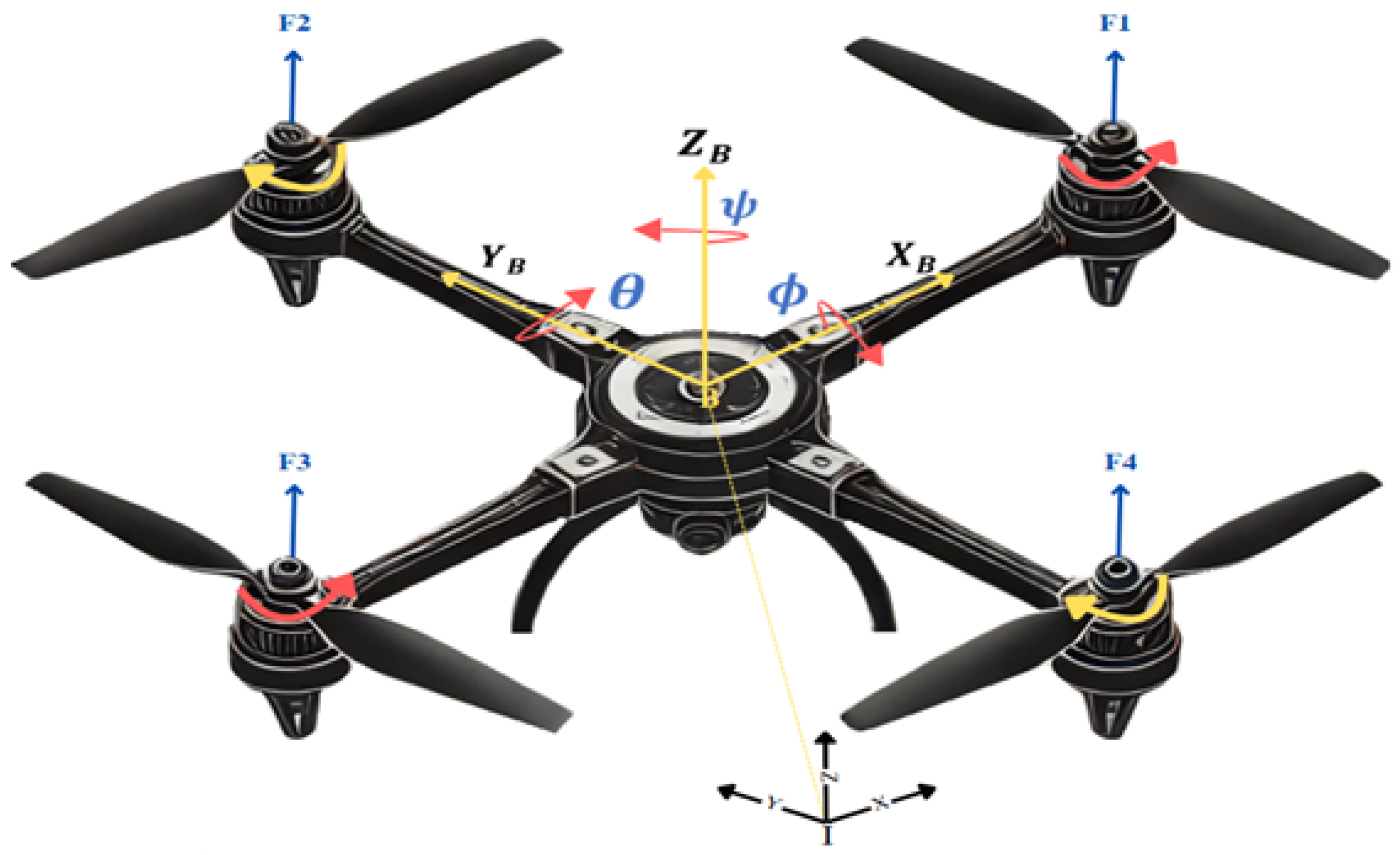
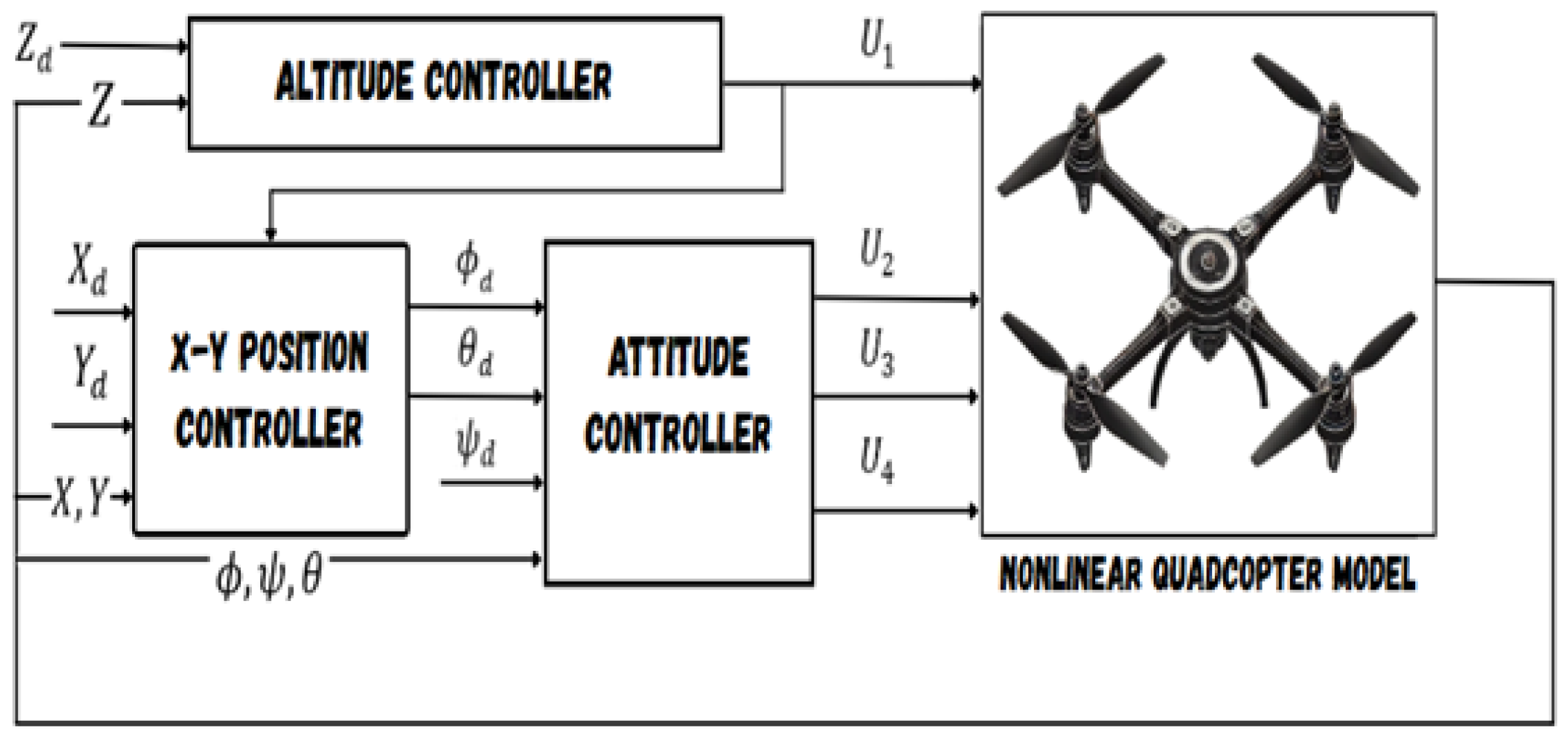
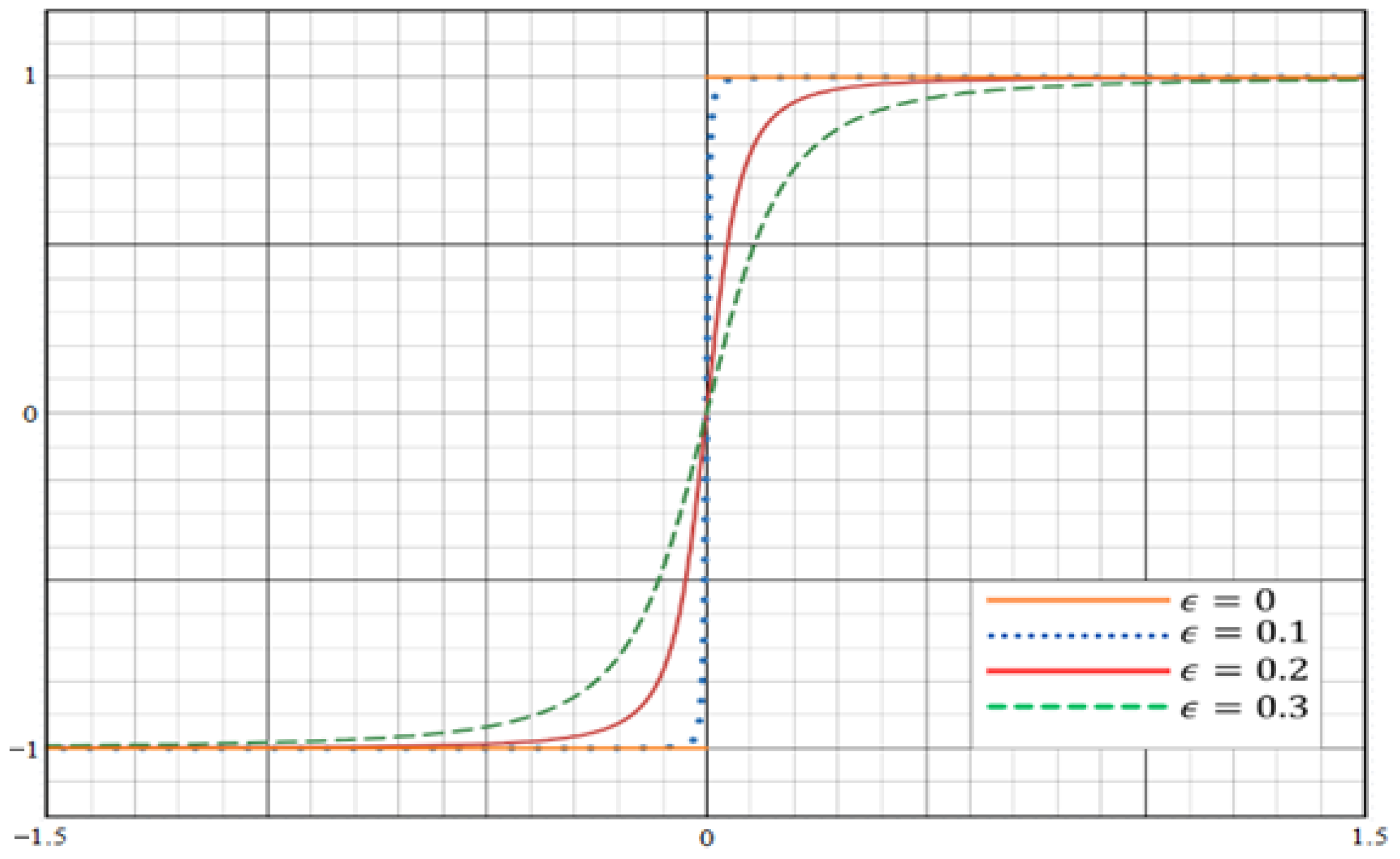
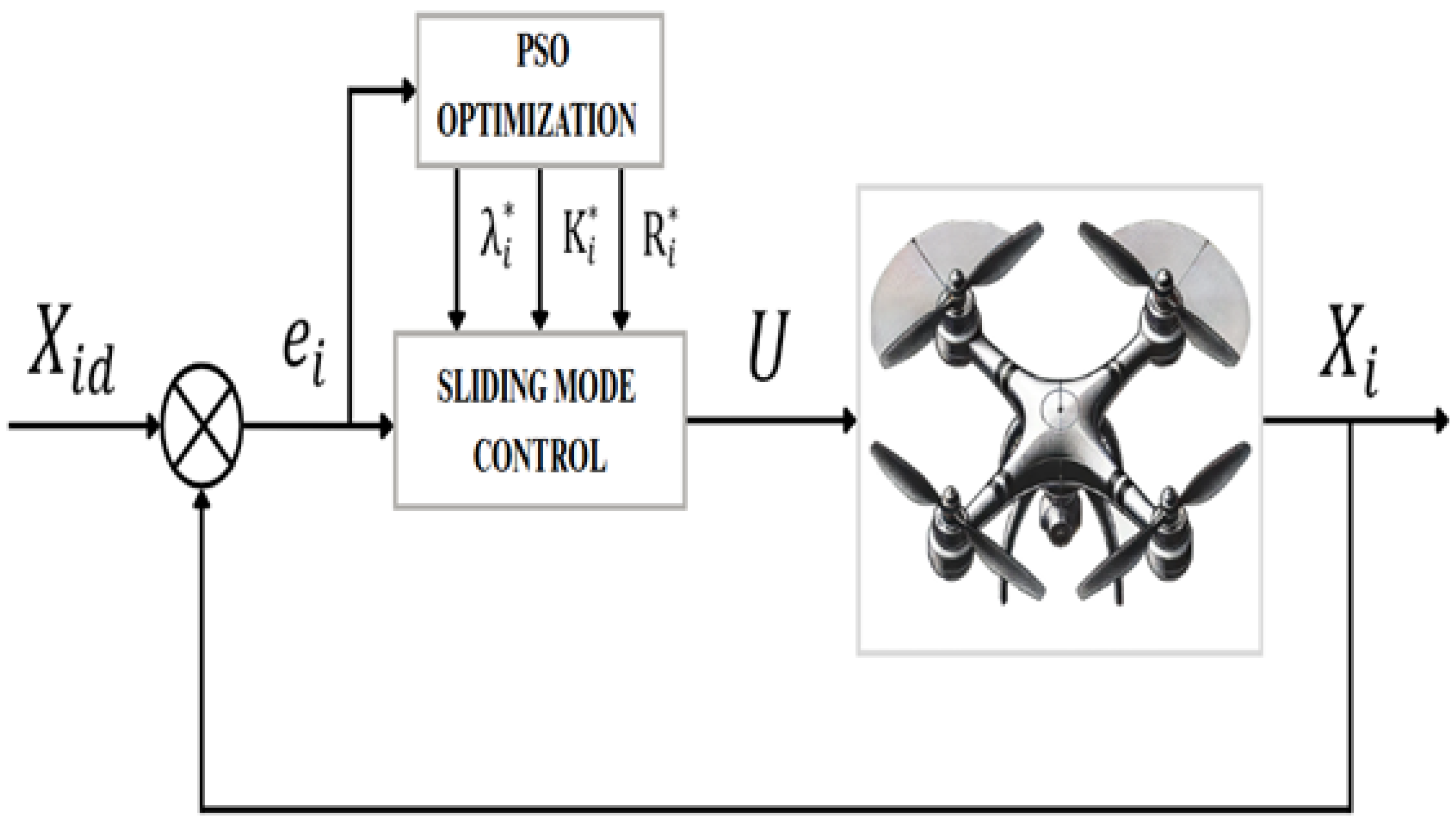
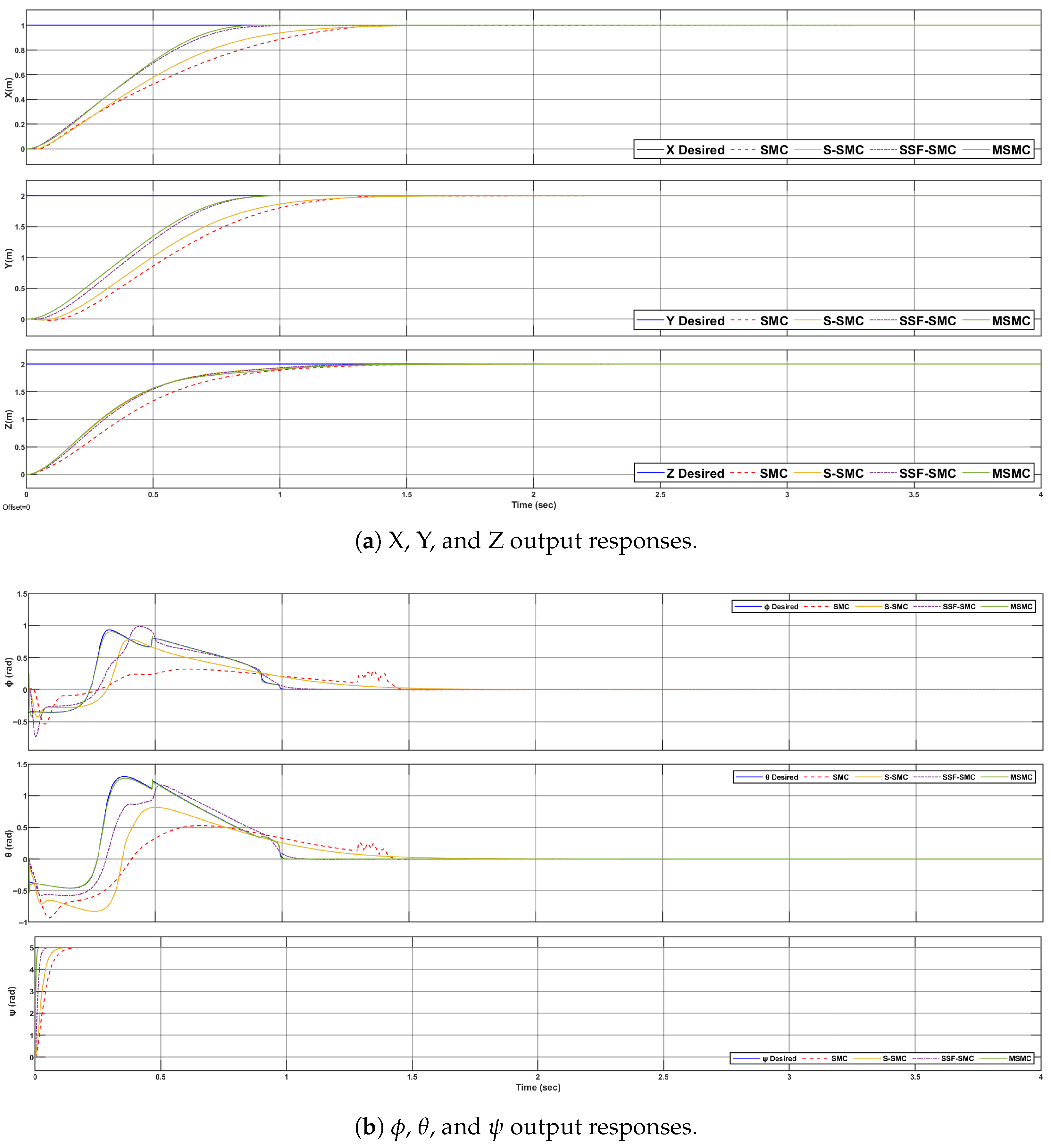
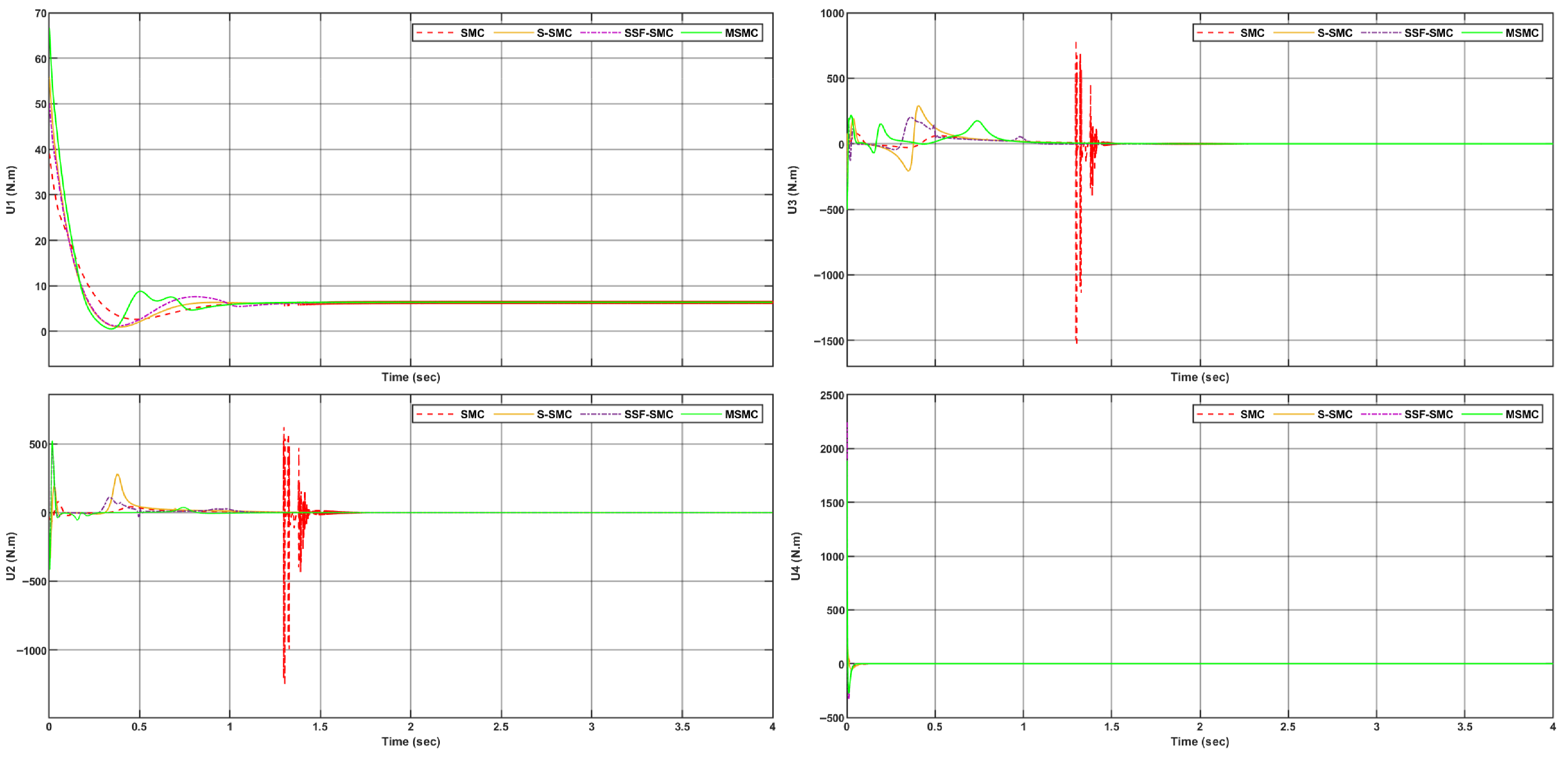
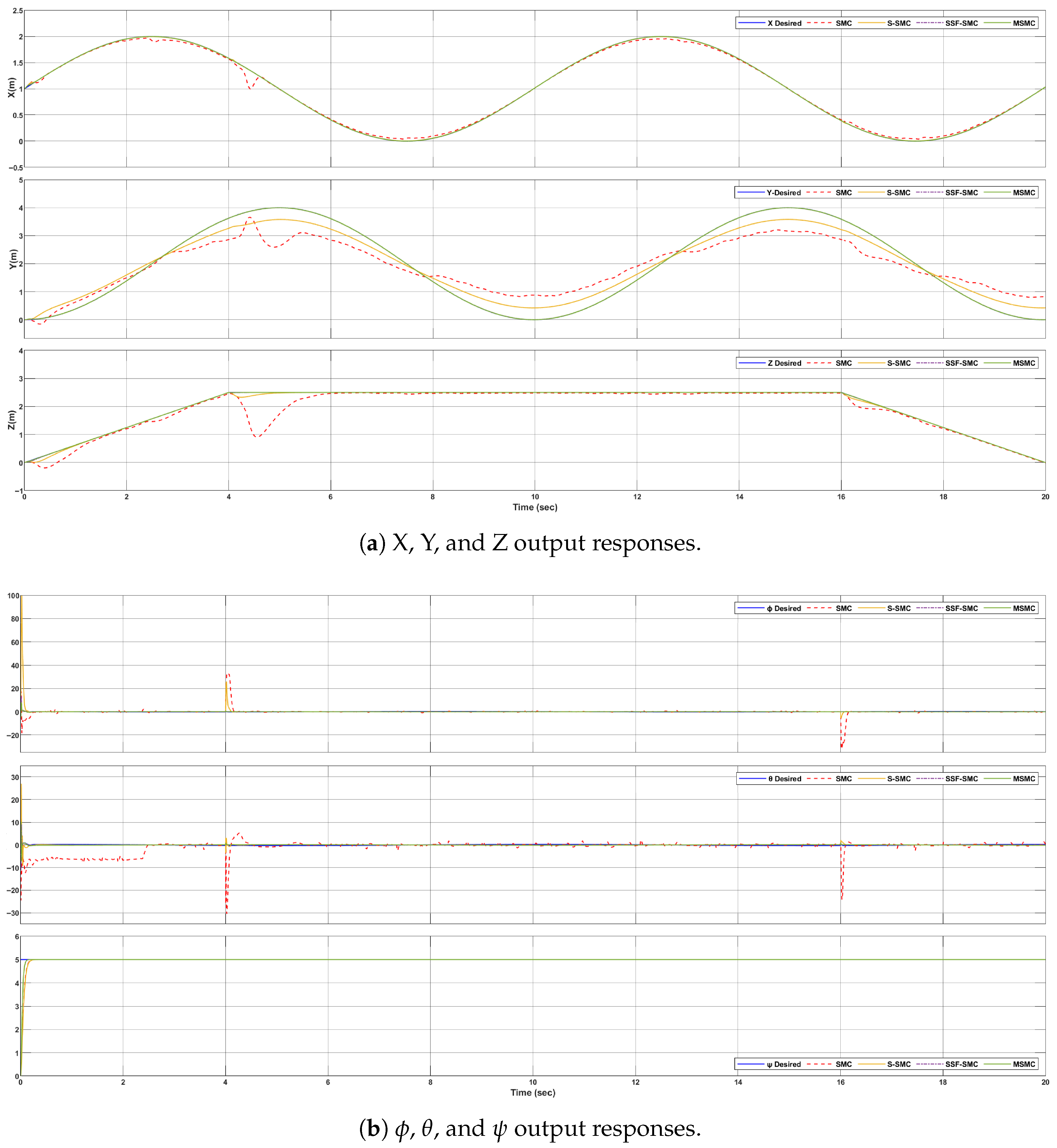
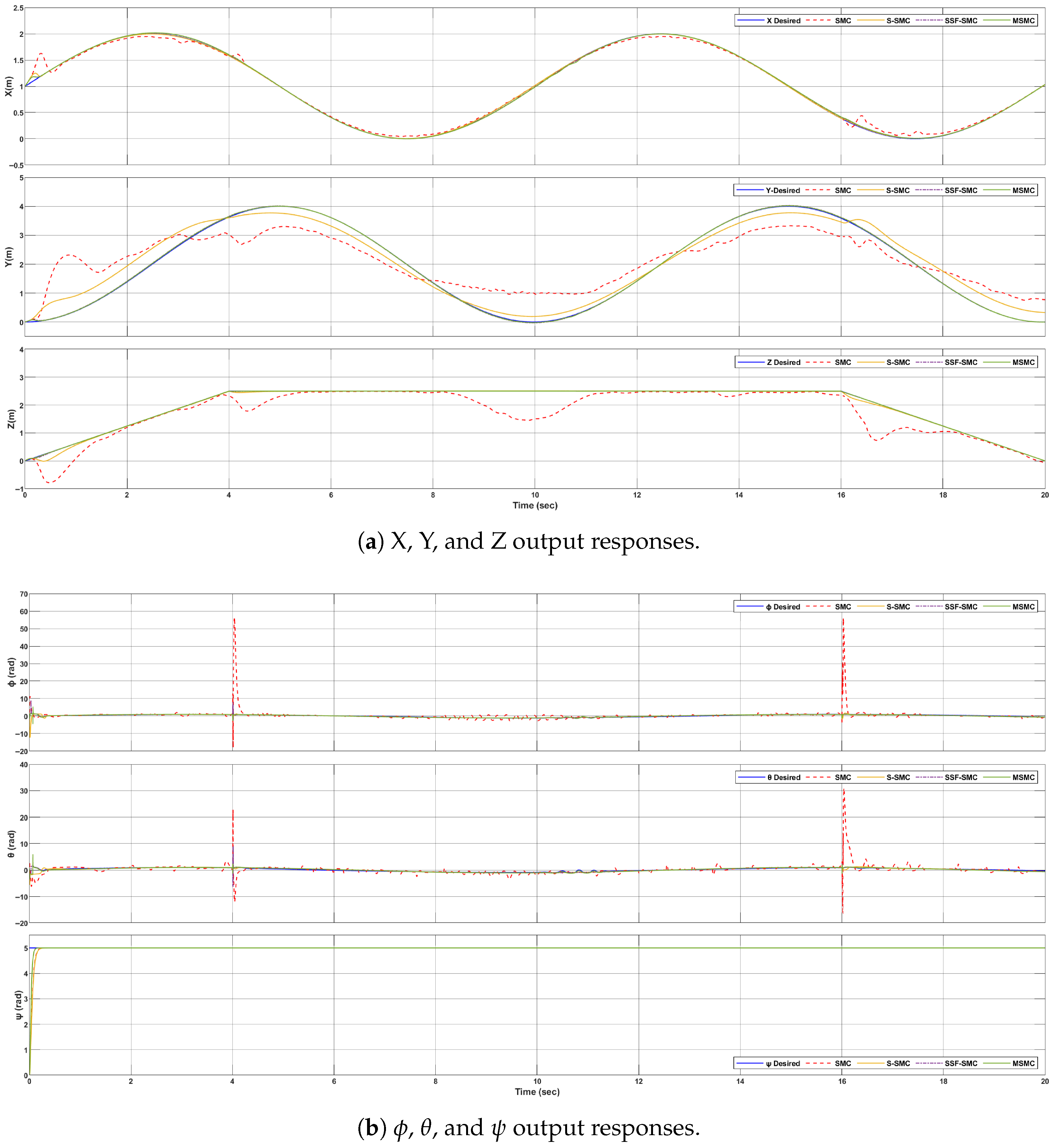
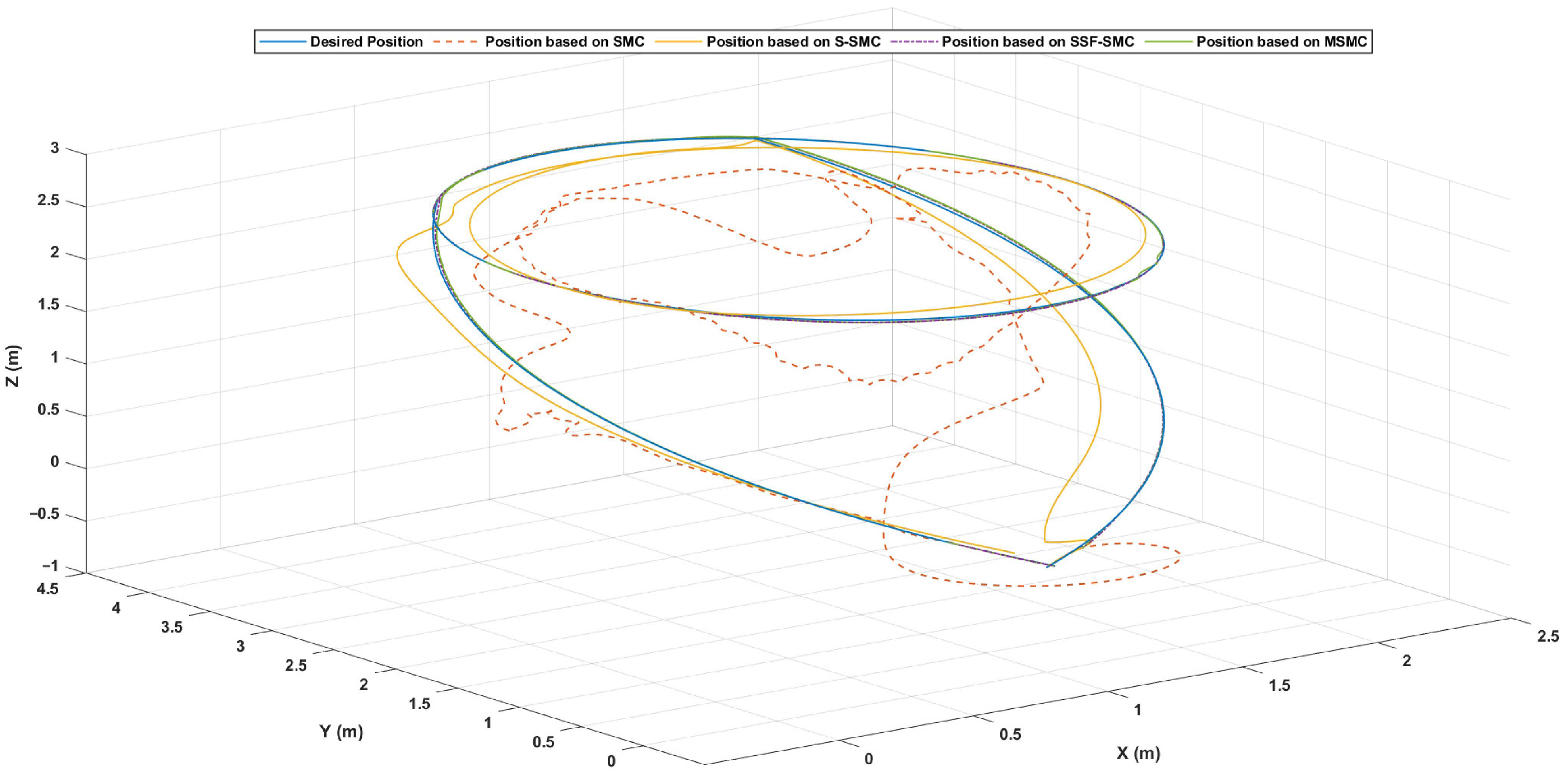
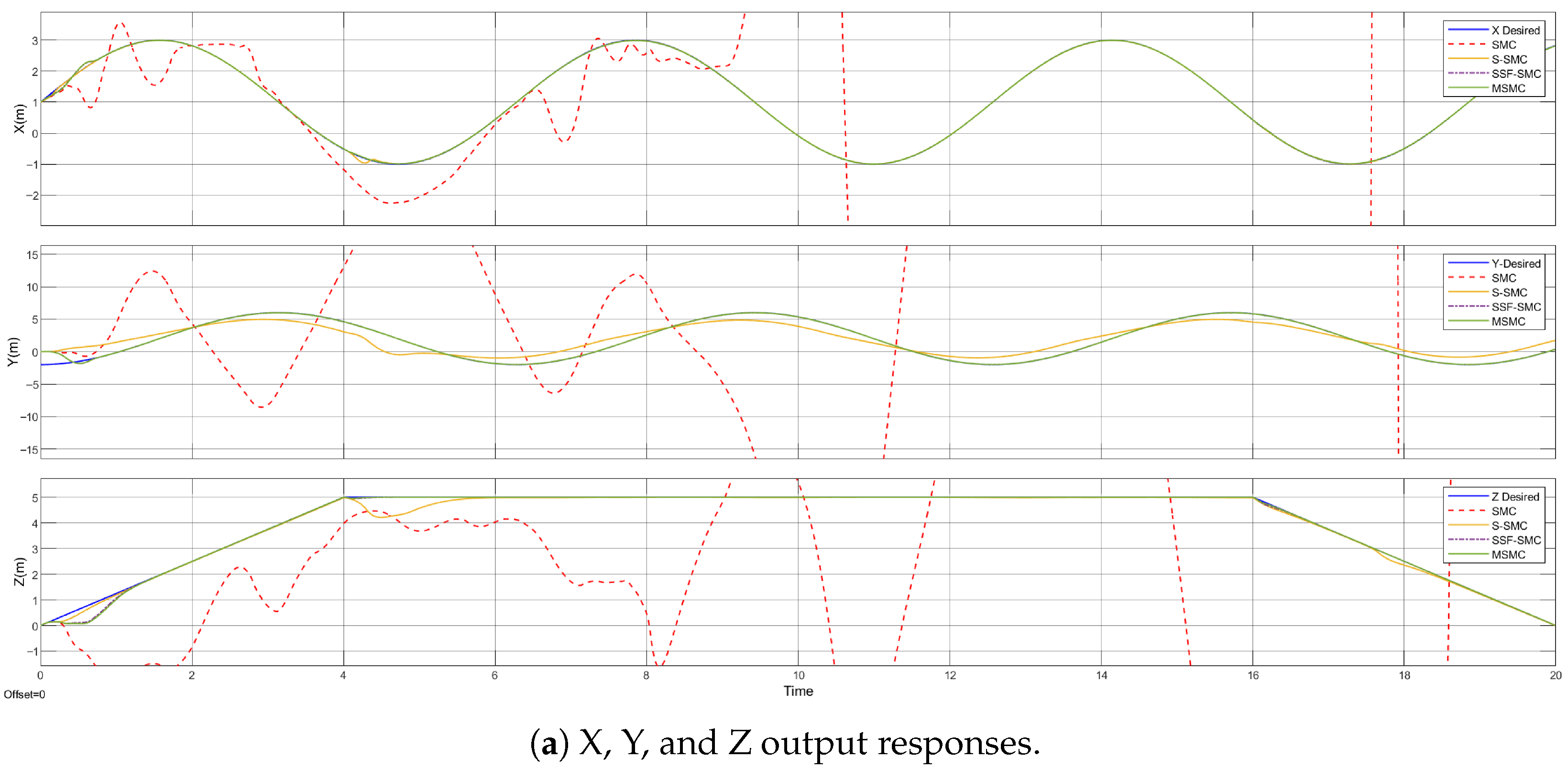
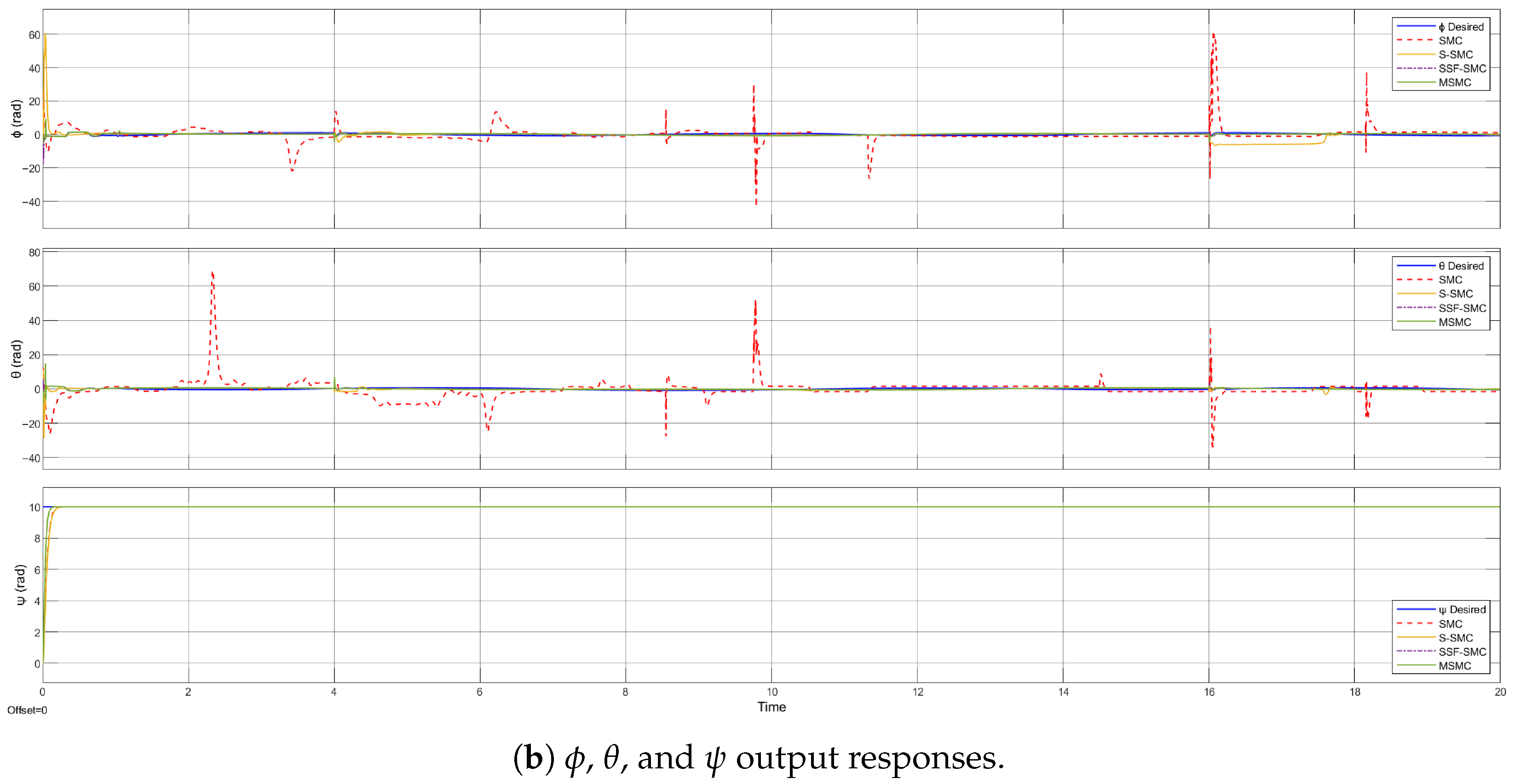
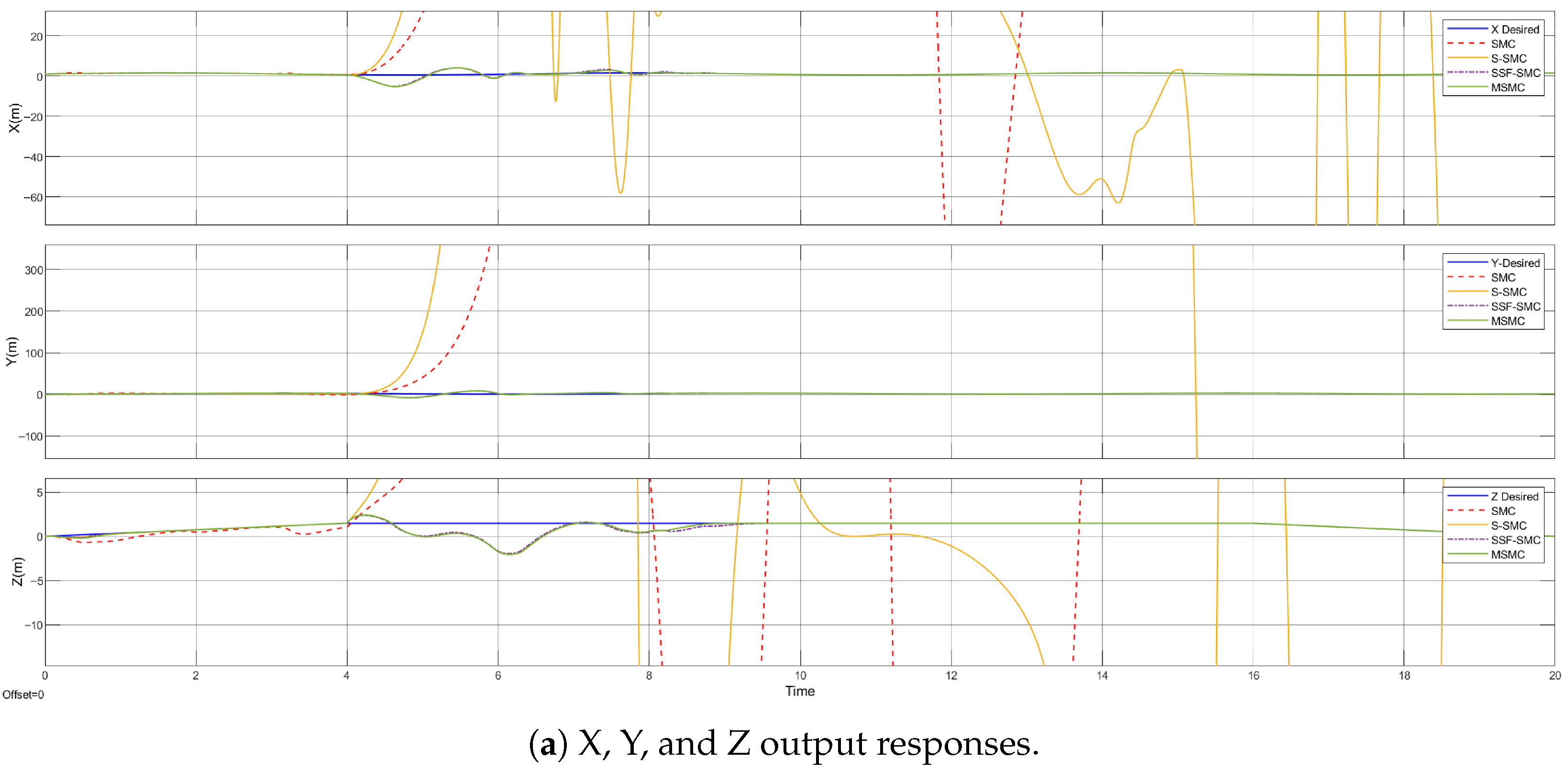

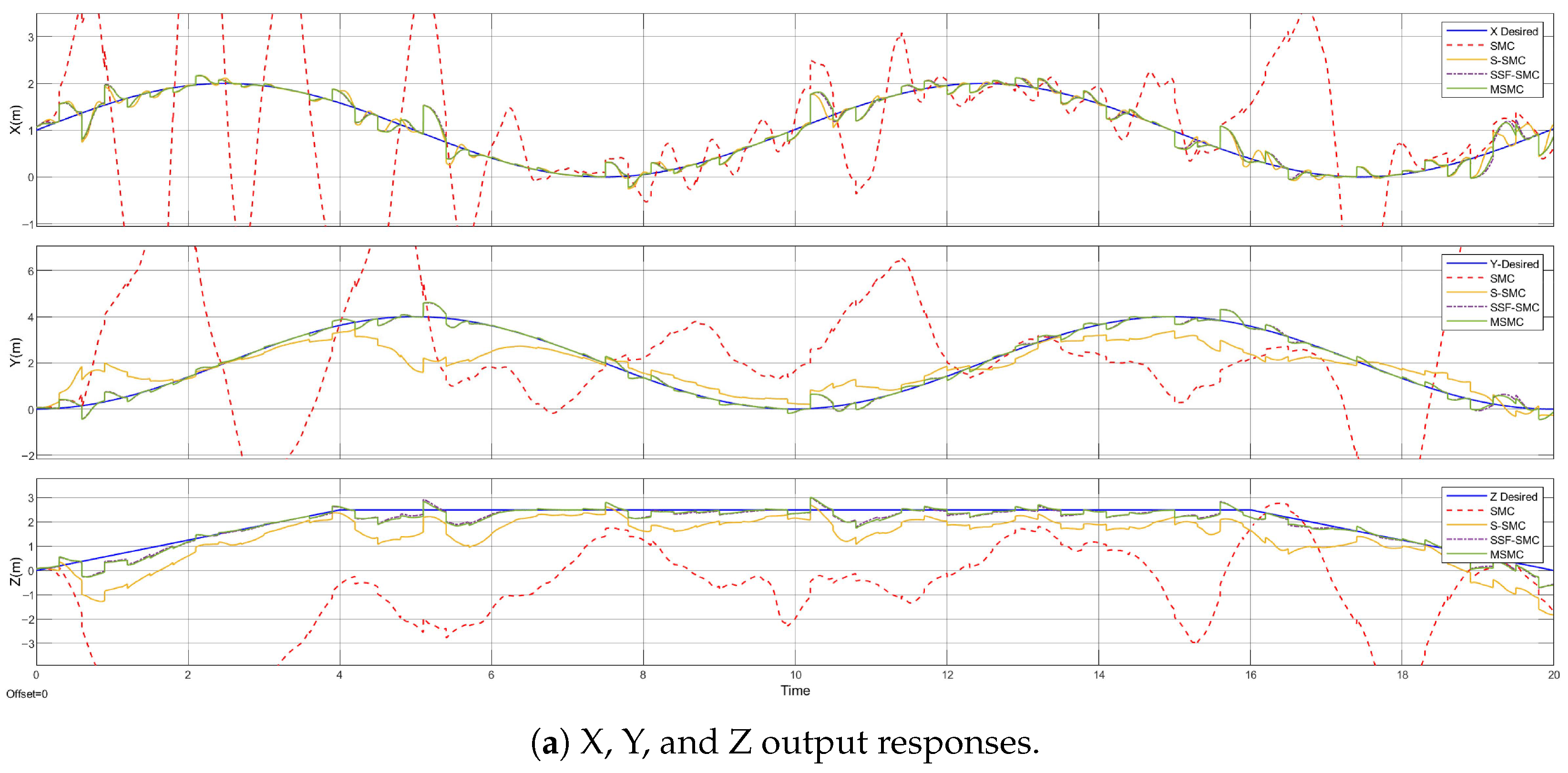

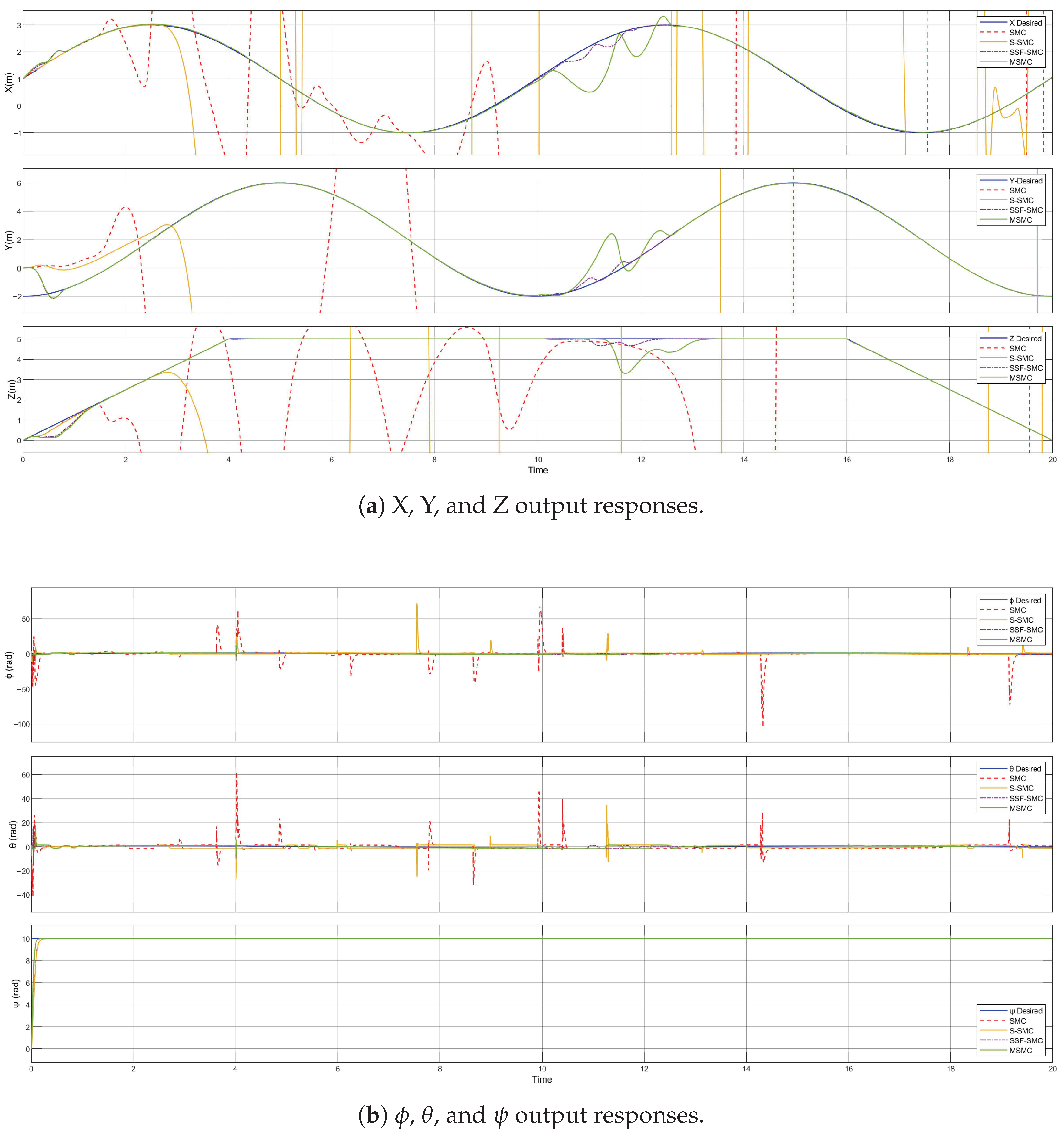
| Parameter | Definition | Value |
|---|---|---|
| b | Thrust coefficient | N·m/rad/s |
| d | Drag coefficient | N·m/rad/s |
| g | Gravity acceleration | |
| Inertia around x-axis | ||
| Inertia around y-axis | ||
| Inertia around z-axis | ||
| Rotor inertia | ||
| Aerodynamic friction coefficient in x | N/rad/s | |
| Aerodynamic friction coefficient in y | N/rad/s | |
| Aerodynamic friction coefficient in z | N/rad/s | |
| Translational drag coefficient in x | N/m/s | |
| Translational drag coefficient in y | N/m/s | |
| Translational drag coefficient in z | N/m/s | |
| l | Quadcopter arm length | m |
| m | Quadcopter mass | kg |
| Quadcopter Output | Optimal Parameter | Sign Function | Saturation Function | SSF | Modified ERL |
|---|---|---|---|---|---|
| 3.75243 | 0.00001 | 7.99816 | 7.94719 | ||
| 67.03035 | 212.80940 | 124.86942 | 153.14592 | ||
| – | – | – | 1.48729 | ||
| 0.00001 | 2.89651 | 1.27273 | 0.08776 | ||
| 82.44825 | 175.80519 | 173.86590 | 132.69362 | ||
| – | – | – | 4.17532 | ||
| 3.74008 | 0.81539 | 1.41473 | 6.96150 | ||
| 49.26941 | 73.23008 | 185.83627 | 171.37256 | ||
| – | – | – | 0.27411 | ||
| x | 0.00001 | 6.00547 | 2.89196 | 18.15754 | |
| 2.13331 | 3.69706 | 3.40799 | 3.04928 | ||
| – | – | – | 1.57180 | ||
| y | 0.00001 | 2.48297 | 3.97825 | 48.46309 | |
| 3.91519 | 4.26076 | 4.22160 | 2.79202 | ||
| – | – | – | 0.00001 | ||
| z | 0.53839 | 1.26397 | 2.36012 | 35.56046 | |
| 4.99033 | 6.17652 | 5.69886 | 6.81947 | ||
| – | – | – | 1.40125 |
| Quadcopter Output | Performance Index | SMC | S-SMC | SSF-SMC | MSMC |
|---|---|---|---|---|---|
| ISE1 | 0.0208 | 0.0026 | 0.0083 | 0.0008 | |
| MSE1 | 2.3744 | 1.2538 | 0.0540 | 0.0226 | |
| ISE2 | 0.0273 | 0.0098 | 0.0076 | 0.0004 | |
| MSE2 | 4.5995 | 0.7766 | 0.0521 | 0.0343 | |
| ISE3 | 0.6287 | 0.4217 | 0.1634 | 0.0347 | |
| MSE3 | 0.0437 | 0.0457 | 0.0370 | 0.0262 | |
| x | ISE4 | 0.3388 | 0.3157 | 0.2782 | 0.2492 |
| MSE4 | 0.0041 | 1.2738 × 10−4 | 2.0740 × 10−4 | 1.3440 × 10−4 | |
| y | ISE5 | 1.7165 | 1.5138 | 1.2161 | 1.0743 |
| MSE5 | 0.4863 | 0.0911 | 3.5796 × 10−4 | 2.1168 × 10−4 | |
| z | ISE6 | 1.0957 | 0.8760 | 0.9091 | 0.8459 |
| MSE6 | 0.1941 | 0.0016 | 1.9995 × 10−4 | 3.9379 × 10−6 | |
| Total CF1 | 5.2544 | 4.1762 | 3.4748 | 2.9630 | |
| Total CF2 | 7.7022 | 2.1689 | 0.2128 | 0.0835 | |
Disclaimer/Publisher’s Note: The statements, opinions and data contained in all publications are solely those of the individual author(s) and contributor(s) and not of MDPI and/or the editor(s). MDPI and/or the editor(s) disclaim responsibility for any injury to people or property resulting from any ideas, methods, instructions or products referred to in the content. |
© 2025 by the authors. Licensee MDPI, Basel, Switzerland. This article is an open access article distributed under the terms and conditions of the Creative Commons Attribution (CC BY) license (https://creativecommons.org/licenses/by/4.0/).
Share and Cite
Mahmood, A.A.; García, F.; Al-Kaff, A. A Novel Design of a Sliding Mode Controller Based on Modified ERL for Enhanced Quadcopter Trajectory Tracking. Drones 2025, 9, 737. https://doi.org/10.3390/drones9110737
Mahmood AA, García F, Al-Kaff A. A Novel Design of a Sliding Mode Controller Based on Modified ERL for Enhanced Quadcopter Trajectory Tracking. Drones. 2025; 9(11):737. https://doi.org/10.3390/drones9110737
Chicago/Turabian StyleMahmood, Ahmed Abduljabbar, Fernando García, and Abdulla Al-Kaff. 2025. "A Novel Design of a Sliding Mode Controller Based on Modified ERL for Enhanced Quadcopter Trajectory Tracking" Drones 9, no. 11: 737. https://doi.org/10.3390/drones9110737
APA StyleMahmood, A. A., García, F., & Al-Kaff, A. (2025). A Novel Design of a Sliding Mode Controller Based on Modified ERL for Enhanced Quadcopter Trajectory Tracking. Drones, 9(11), 737. https://doi.org/10.3390/drones9110737











